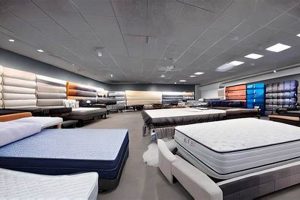Safeguarding a bed’s foundation during periods of transition or relocation necessitates proper preparation and methodology. This involves measures designed to prevent damage from moisture, pests, and physical stress while the item is not in use, particularly within a self-storage environment.
Effective preservation extends the lifespan of the item, protecting a significant investment. Thoughtful implementation of preventative strategies mitigates the risk of costly replacements due to mildew, infestation, or structural degradation. The ability to properly protect a sleeping surface offers both economical and practical advantages when space constraints demand temporary warehousing.
The subsequent sections will delineate specific steps to ensure optimal preservation, including cleaning protocols, protective wrapping techniques, and strategic placement within the storage unit to minimize potential harm.
Preservation Strategies for Bedding During Storage
The following outlines essential steps for ensuring the safe and secure warehousing of a bed’s support structure. Adherence to these guidelines minimizes the risk of damage and prolongs the life of the product.
Tip 1: Cleaning and Preparation: Thoroughly vacuum the entire surface to remove dust mites, dirt, and debris. Address any stains with appropriate cleaning solutions, ensuring the surface is completely dry before proceeding.
Tip 2: Protective Wrapping: Encase the mattress in a specialized storage bag or heavy-duty plastic sheeting. Seal all openings with packing tape to create a barrier against moisture, pests, and dust.
Tip 3: Orientation and Positioning: Store the item flat, if possible, to maintain its structural integrity and prevent sagging. If upright storage is unavoidable, ensure it is properly supported to avoid bending or distortion.
Tip 4: Elevated Placement: Utilize pallets or wooden planks to elevate the product off the floor of the storage unit. This creates airflow and reduces the risk of moisture absorption from the concrete.
Tip 5: Climate Control Considerations: Opt for a climate-controlled storage unit, if feasible, to regulate temperature and humidity levels. This further protects against mold, mildew, and deterioration of materials.
Tip 6: Regular Inspections: Periodically check the storage unit and inspect the item for signs of damage or moisture. Address any issues promptly to prevent further degradation.
Tip 7: Dehumidifying Agents: Consider placing moisture-absorbing products, such as silica gel packets or dehumidifying crystals, inside the storage bag to further control humidity levels.
These preventative measures collectively minimize potential risks, safeguarding the bedding’s integrity and usability for future use.
Implementing these precautions represents a responsible approach to long-term bedding preservation, ensuring the item remains in optimal condition throughout its time in storage.
1. Cleanliness
The state of cleanliness of a sleeping surface prior to placement within a storage unit directly affects its long-term integrity. Organic matter, such as skin cells, dust mite excrement, and spilled liquids, provides a breeding ground for mold, mildew, and bacteria when confined in the typically less-than-ideal environment of a storage facility. Failure to adequately cleanse the item prior to storage significantly increases the risk of irreversible damage. For instance, a mattress harboring even trace amounts of moisture from a spill can develop extensive mold growth within weeks, rendering it unusable.
Therefore, a comprehensive cleaning process is an essential initial step. This necessitates thorough vacuuming of all surfaces, including seams and crevices, to remove particulate matter. Stain removal, using appropriate cleaning agents, is crucial to eliminate potential food sources for microorganisms. Critically, the mattress must be allowed to dry completely before being sealed for storage. Dampness sealed within the protective wrapping will inevitably lead to microbial growth, causing staining, unpleasant odors, and potential structural deterioration. Consider that professional mattress cleaning services are available, offering specialized equipment and cleaning solutions to ensure a thorough cleaning process, especially for heavily soiled items.
In summary, the cleanliness of the item before storing represents a critical preventative measure. Inadequate cleaning establishes an environment conducive to degradation, while a thorough cleaning minimizes the risk of long-term damage, thereby preserving the quality and usability of the item for future use. The time and effort invested in pre-storage cleaning are directly proportional to the likelihood of successfully preserving the bed’s integrity throughout its storage period.
2. Protection
Protection forms a foundational element in effectively preserving a sleeping surface within a storage environment. The term encompasses a range of strategies aimed at shielding the item from detrimental factors prevalent in such settings. These strategies, when properly implemented, significantly reduce the risk of damage and degradation during the storage period. Protection, therefore, is not merely an optional consideration but a crucial aspect of responsible mattress warehousing.
- Moisture Barrier
A primary threat to stored bedding is moisture. Humidity fluctuations and potential leaks within the storage unit can lead to water damage, fostering mold and mildew growth. A robust moisture barrier, typically in the form of a specialized mattress storage bag or heavy-duty plastic sheeting, is essential. This barrier should completely encase the mattress and be securely sealed with packing tape to prevent moisture penetration. Failure to establish an effective moisture barrier can result in irreversible damage, rendering the mattress unusable.
- Pest Deterrence
Storage units can be susceptible to pest infestations, with rodents, insects, and other creatures seeking shelter and sustenance. These pests can cause significant damage to the mattress fabric and internal components. Protective encasements, particularly those made of durable, puncture-resistant materials, serve as a physical barrier against pest entry. Additionally, the application of pest deterrents, such as cedar chips or mothballs (used cautiously and appropriately), can further discourage infestations. Neglecting pest deterrence measures exposes the mattress to potential damage and contamination.
- Physical Damage Mitigation
Physical damage, such as tears, abrasions, and indentations, can occur during handling and storage. A protective covering provides a buffer against these potential harms. The encasement should be thick enough
to withstand minor impacts and resist tearing. Furthermore, proper handling techniques, such as using furniture dollies and avoiding dragging the mattress, are crucial in preventing physical damage. Insufficient protection increases the likelihood of cosmetic and structural damage to the item. - Dust and Allergen Control
Storage environments can accumulate dust and allergens over time. A sealed protective encasement prevents these contaminants from settling on the mattress surface. This is particularly important for individuals with allergies or sensitivities. The encasement should be made of a material that is both dust-proof and allergen-proof. Neglecting dust and allergen control can result in a less hygienic and comfortable sleeping surface upon retrieval.
In conclusion, the concept of protection when considering the most effective way to keep a bed’s support base safe during storage encompasses a multi-faceted approach, with moisture control, pest deterrence, physical damage mitigation, and dust/allergen control all playing vital roles. Comprehensive protection, executed through the use of appropriate materials and techniques, maximizes the likelihood of preserving the item in optimal condition throughout the duration of storage, representing a sound investment in its long-term usability.
3. Positioning
The orientation of a sleeping surface within a storage unit significantly impacts its structural integrity and long-term usability. Incorrect positioning can induce stress, leading to deformation and accelerated wear. Proper placement, therefore, is not merely a matter of convenience but a critical aspect of responsible preservation. The effects of improper placement are cumulative, potentially resulting in irreversible damage over time. For example, a heavy innerspring mattress left leaning against a wall for an extended period can develop a permanent sag, compromising its support and comfort. Proper positioning mitigates these risks, ensuring the product remains in optimal condition.
The optimal approach involves storing the item horizontally on a flat surface. This distributes weight evenly, minimizing pressure points and preventing distortion. Utilizing pallets or wooden planks to elevate the mattress off the floor further enhances stability and promotes air circulation, reducing the risk of moisture accumulation. However, space constraints often necessitate vertical storage. In such cases, the mattress should be positioned upright against a sturdy wall, secured to prevent tipping, and ideally supported along its entire length to distribute the load. Regularly rotating the mattress, even when stored vertically, can help to alleviate pressure build-up in specific areas. Furthermore, avoiding stacking other items on top of a stored mattress, regardless of its orientation, prevents compression and potential damage to the internal components.
In conclusion, the positioning of a mattress within a storage unit is a crucial determinant of its long-term condition. Horizontal storage is the preferred method, but when space limitations dictate vertical placement, proper support and regular rotation are essential to mitigate the risks of deformation. Understanding the principles of weight distribution and stress reduction informs effective positioning strategies, contributing to the successful preservation of the mattress throughout its storage period. Neglecting proper placement can lead to avoidable damage, resulting in a compromised sleeping surface upon retrieval.
4. Environment
The environmental conditions within a storage unit exert a profound influence on the condition of a stored mattress. Fluctuations in temperature and humidity, exposure to pests, and the presence of contaminants can degrade materials, foster microbial growth, and compromise the overall integrity of the item. Ignoring these environmental factors during storage preparation is a significant oversight, often resulting in substantial and irreversible damage. The storage unit environment, therefore, must be carefully considered and managed to ensure the safe and effective long-term preservation of bedding.
One critical aspect is humidity control. Elevated humidity levels promote the growth of mold and mildew, which can stain the mattress, generate unpleasant odors, and weaken fabric fibers. Conversely, excessively dry conditions can cause materials to become brittle and crack. Climate-controlled storage units, which maintain consistent temperature and humidity levels, provide an optimal environment for mattress preservation, significantly reducing the risk of moisture-related damage. However, if a climate-controlled unit is not feasible, strategies such as using dehumidifying agents within the sealed mattress encasement and ensuring adequate ventilation within the storage unit can help mitigate humidity fluctuations. Real-world examples demonstrate the devastating effects of unchecked humidity; mattresses stored in non-climate-controlled units in humid climates often exhibit extensive mold growth within a few months, rendering them unsalvageable. Beyond humidity, pest control is also critical. Storage units can harbor rodents and insects, which can damage the mattress fabric and internal components. Regular pest control measures, such as bait stations and insecticide treatments (applied by qualified professionals), can help prevent infestations. The presence of airborne contaminants, such as dust and pollutants, can also degrade the mattress over time. Sealing the mattress in a high-quality storage bag minimizes exposure to these contaminants, preserving its cleanliness and integrity. The specific requirements of the storage environment may vary depending on the location and climate. For example, in areas with significant temperature fluctuations, insulating the storage unit can help moderate temperature swings and prevent condensation.
In summary, the storage environment represents a crucial determinant of a mattress’s long-term condition. Proactive management of humidity, pests, and contaminants is essential to prevent damage and ensure the item remains usable. While climate-controlled units offer the most reliable solution, alternative strategies can be implemented to mitigate environmental risks. Understanding and addressing the specific environmental challenges of the storage location are key to successful mattress preservation, and the effort to create the right enviornment will ultimately extend the life and usability of the mattress.
5. Elevation
The act of elevating a mattress within a storage unit serves a critical function in mitigating moisture-related damage. Direct contact with the floor, frequently concrete, exposes the item to moisture seepage, condensation, and potential flooding. This moisture, trapped between the mattress and the floor, creates an environment conducive to mold and mildew growth, resulting in irreversible damage and rendering the mattress unusable. Elevation breaks this contact, promoting air circulation and allowing any accumulated moisture to evaporate, thus minimizing the risk of microbial proliferation. A practical example of the benefits of elevation can be found in comparing two identical mattresses placed in similar storage units. The mattress directly on the floor develops visible mold within weeks, wh
ile the elevated mattress remains unaffected. This illustrates the direct cause-and-effect relationship between floor contact and moisture-related damage.
Various methods can be employed to achieve effective elevation. Pallets, wooden planks, or even sturdy plastic sheeting can be utilized to create a barrier between the mattress and the floor. The choice of material depends on availability, cost, and the overall weight of the mattress. Regardless of the method, ensuring stable and even support is crucial to prevent distortion or sagging. Uneven elevation can create pressure points, leading to localized compression and ultimately, damage to the mattress’s internal structure. The effectiveness of elevation is further enhanced when combined with other protective measures, such as proper wrapping and climate control, creating a multi-layered defense against environmental damage. This approach is particularly important in regions with high humidity or a history of flooding, where the risk of moisture-related problems is significantly increased.
In conclusion, elevation is an indispensable component of successful long-term mattress storage. It effectively disrupts the direct contact between the mattress and the moisture-prone floor, promoting air circulation and minimizing the risk of mold and mildew growth. While challenges such as space constraints and the availability of suitable elevation materials may arise, the benefits of this simple measure far outweigh the associated difficulties. Understanding and implementing elevation strategies directly contribute to preserving the integrity and usability of the stored mattress, preventing costly damage and ensuring its readiness for future use. The application of this principle exemplifies the broader theme of proactive preparation in safeguarding valuable possessions during periods of storage.
6. Monitoring
The long-term preservation of a sleeping surface within a storage unit necessitates periodic monitoring of its condition and the surrounding environment. The absence of consistent oversight can negate the benefits of initial protective measures, allowing undetected issues to escalate into significant damage. Monitoring serves as a crucial feedback loop, enabling timely intervention and preventing potentially irreversible degradation. Consider a situation where a seemingly well-sealed mattress encasement sustains a minor tear during handling. Without regular inspection, this tear might go unnoticed, allowing moisture and pests to enter, leading to mold growth and infestation. Such a scenario underscores the importance of proactive monitoring as an integral component of responsible storage practices.
Effective monitoring involves a systematic assessment of both the mattress itself and the storage unit environment. This includes visual inspection for signs of moisture, pest activity, or physical damage to the encasement. Additionally, olfactory cues, such as musty odors, can indicate the presence of mold or mildew. Humidity levels within the storage unit should be periodically checked, especially in non-climate-controlled environments. Furthermore, the stability of the mattress positioning should be verified, ensuring it remains properly supported and protected from external pressure. Addressing detected issues promptly is paramount. A torn encasement should be repaired or replaced immediately, and any signs of pest activity should be addressed with appropriate pest control measures. Similarly, high humidity levels can be mitigated by using dehumidifying agents or improving ventilation within the unit. Neglecting these corrective actions allows minor problems to compound, jeopardizing the long-term integrity of the stored mattress. A practical example would be the deployment of wireless sensors that track temperature and humidity inside a storage unit, sending alerts to a user’s device upon the detection of anomalous conditions.
In summary, monitoring is not merely a supplementary activity but an essential element of proper bedding warehousing. It transforms a passive storage approach into an active preservation strategy, enabling early detection and mitigation of potential threats. By incorporating regular inspections and prompt corrective actions, individuals can significantly increase the likelihood of preserving a sleeping surface in optimal condition throughout its storage period. The time and resources invested in monitoring represent a prudent investment, safeguarding the item’s value and ensuring its continued usability.
Frequently Asked Questions Regarding Proper Bedding Warehousing
The following addresses common inquiries pertaining to best practices for protecting bedding during periods of storage. Adherence to these guidelines will help mitigate potential damage and ensure the item’s longevity.
Question 1: Is professional cleaning necessary prior to placement within a storage facility?
Professional cleaning is highly recommended, especially for mattresses exhibiting visible stains or suspected allergen contamination. Professional services employ specialized equipment and cleaning agents, ensuring thorough removal of dirt, dust mites, and other contaminants. However, thorough vacuuming and spot cleaning can suffice for mattresses in relatively clean condition.
Question 2: What type of encasement provides optimal protection?
A heavy-duty, waterproof, and puncture-resistant mattress storage bag is ideal. The encasement should completely seal the mattress, preventing moisture penetration, pest infestation, and dust accumulation. Consider encasements made from breathable materials to minimize condensation buildup.
Question 3: Does the storage unit require climate control?
Climate-controlled storage is strongly recommended, particularly in regions with significant temperature and humidity fluctuations. Climate control maintains a stable environment, preventing mold growth, mildew formation, and material degradation. Non-climate-controlled units pose a higher risk of damage.
Question 4: Is vertical storage acceptable?
Horizontal storage is preferable to distribute weight evenly and prevent structural distortion. If vertical storage is unavoidable due to space constraints, ensure the mattress is properly supported along its entire length to prevent bending or sagging. Rotate the mattress periodically to alleviate pressure points.
Question 5: How often should the stored mattress be inspected?
The mattress and storage unit environment should be inspected at least every three months. Check for signs of moisture, pest activity, or damage to the encasement. Promptly address any detected issues to prevent further degradation.
Question 6: Are there specific considerations for storing memory foam mattresses?
Memory foam mattresses are particularly susceptible to temperature and humidity fluctuations. Climate-controlled storage is highly recommended. Additionally, avoid compressing or folding memory foam mattresses, as this can damage the internal structure. Store them flat whenever possible.
Proper preparation and diligent monitoring are essential for successful bedding warehousing. Adhering to the recommendations outlined above will significantly reduce the risk of damage and ensure the item remains in usable condition for future use.
The subsequent section will address additional resources and professional assistance available for mattress storage and preservation.
Proper Bedding Warehousing
This exploration of “how to store a mattress in storage unit” has underscored the importance of meticulous prepara
tion, strategic placement, and consistent monitoring. Cleaning, protection, positioning, environmental control, elevation, and regular inspections represent critical components of a comprehensive preservation strategy. Neglecting these aspects increases the likelihood of damage, potentially rendering the mattress unusable. Conversely, diligent application of these principles maximizes the item’s lifespan and ensures its readiness for future use.
The long-term condition of a stored mattress is directly proportional to the effort invested in proper warehousing practices. Implementing these recommendations demonstrates responsible asset management, safeguarding a significant investment and preventing unnecessary replacement costs. Continued diligence in adhering to these guidelines will yield enduring benefits, preserving the integrity and usability of the mattress for years to come.







